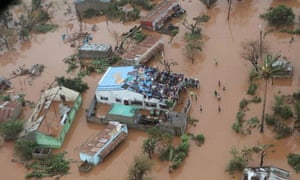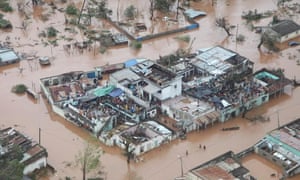
Mozambique rescue teams struggle to save thousands
Rescue teams in Mozambique are struggling to reach the thousands of people stranded on roofs and in trees and urgently need more helicopters and boats as post-cyclone flood waters continue to rise.
Mozambique, which was hit by Cyclone Idai over the weekend, has declared a state of emergency and is appealing for international help.
Rescue workers, military personnel and volunteers are rushing to save thousands of Mozambicans before flood levels rise further, but with four helicopters, a handful of boats and extremely difficult conditions, have only been able to save about 413 so far.
Buzi district is thought to have been more badly affected than Beira. Photograph: INGC
“I don’t even know if we’ve made a dent. There are just so many people. The scale is huge. We’re busy doing the best we can,” said Travis Trower from Rescue South Africa, adding that a lot of people had been washed away but those still alive, whom he had seen from helicopter flights, were in a very bad state.
“We’re often a couple of metres off the ground, so we’re really close to them. We see they’re frail, they’re tired, they’re hungry. There’s no water, no food, they’re in the cold at night. It’s devastating.”
More than 400 sq kilometres (150 sq miles) in the region are flooded, according to satellite images taken by the EU, and in some places the water is six metres (19ft) deep. At least 600,000 people are affected, according to the UN Office for the Coordination of Humanitarian Affairs (OCHA), ranging from those whose lives are in immediate danger to those who need other kinds of aid.
With heavy rains still falling in the region, floodwaters are predicted to rise in the coming days, meaning more people will need to be rescued; Mozambique’s president, Filipe Nyusi, warned there could be waves up to eight metres high.
Emergency teams are shifting their focus from rescue to delivering aid and evacuating Buzi, a town of 200,000 people that is expected to be partially submerged in the coming surge. Aerial images released by Mozambique’s disaster relief agency, the INGC, showed survivors packed together on top of high buildings in Buzi district, which is the worst affected area.
Survivors cling to buildings in the district of Buzi, Mozambique. Photograph: INGC
The magnitude of the disaster is “almost unexplainable”, with water as far as the eye can see, exhausted and hungry people trapped on exposed rooftops for days and mothers throwing their babies into rescue boats but having to stay behind in the trees they are holding on to, according to a rescue worker in the devastated port city of Beira.
“There are still many many people out there. Because of the mass devastation we are now mainly focusing on the very large groups … it’s very difficult to focus on individuals,” said Trower, whose team cleared the road to the airport and began rescue operations on Saturday.
He said four helicopters were currently involved in rescue operations, with capacities of between four and 35 people per trip. Workers hoped to rescue 1,000 people on Wednesday, but bad weather meant they could only save 170.
“We’re hoping that more [helicopters] arrive today,” he said, though he admitted that he did not know where they would come from.
.
Humanitarian organisations are deploying to Beira, but because large areas are underwater and cut off, with communications down for a fifth day, no power and the main road washed away, getting supplies and staff in and information out is extremely difficult. The airport was badly damaged but is working again and some commercial flights are running from the capital, Maputo.
There is a limited window in which survivors will be able to stay alive, given that most have no access to food and clean water. “It is longer than in an earthquake,” said Jens Laerke of the OCHA. “People will be able to survive longer.”
Mozambique’s death toll was officially 202 on Wednesday, after more than doubling overnight – but this represents the bodies that officials have been able to count, and the real, far higher toll is unlikely to be known for a long time. Many have died and many others in neighbouring Malawi and Zimbabwe are in need of aid too.
Trower described the difficulty of rescuing people, most of whom cannot swim, with boats, using 20-metre lines from helicopters or swimming to them in the trees. Saturday night was the most difficult because of strong currents, he said.
“Mothers were throwing their babies out from the trees to us into our boats and we were then paddling them to shore,” he said. “The water was flowing extremely fast underneath and we couldn’t get into the really strong current or we would have been washed away ourselves.”
Access to food, shelter, clean water and health provision are very high priorities. The government has reported that over 1,000 people are injured.
About 37 basic reception centres, mainly schools that can hold between 100 and 1,000 people, have been set up around Beira. The Guardian understands that UN agencies are examining building two large reception camps to accommodate 400,000 people, which would make providing food and health services easier.
“There’s a need of almost everything,” said the Red Cross’s Caroline Haga in Beira.
At Maputo’s main airport, scores of emergency workers including police search and research teams and staff from UN and other international agencies were beginning to pour into the country, even as some admitted that the scale of the human impact of the cyclone was still barely understood.
UK-funded kits that can provide emergency shelter for up to 38,000 people have arrived in the country, and the Department for International Development has provided funds for two weeks’ worth of food for 120,000 people as part of £18m worth of aid to Mozambique, Malawi and Zimbabwe.
The country began three days of mourning on Wednesday. “We are in an extremely difficult situation,” said Nyusi.
(THE GUARDIAN)



